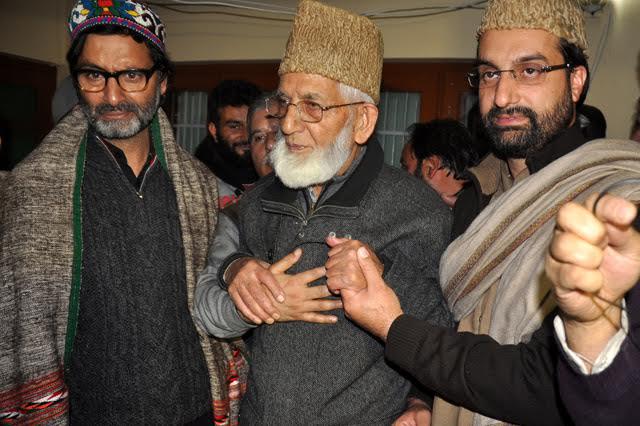by Khursheed Wani
After many years, a complete shutdown across the far and wide of Kashmir Valley was observed on May 21, on the anniversary of Mirwaiz Muhammad Farooq and Abdul Gani Lone. During past several years, the shutdown sponsored by Hurriyat (m) was not evoking much response, especially in south Kashmir. Curious, I asked a south Kashmir resident about the renewed efficacy of the shutdown call. He said it was JRL’s stamp that is primarily responsible.
Joint Resistance Leadership is the new triumvirate of Kashmir politics comprising Syed Ali Geelani, Mirwaiz Umar Farooq and Muhammad Yasin Malik. It owes its genesis to 2016 unrest in wake of militant Burhan Wani’s killing.
The JRL has gradually overhauled the discordant groups of the separatist camp that comprised two factions of Hurriyat Conference (APHC) and several organisations like JKLF, Dukhtaran-e-Millat and Kashmir High Court Bar Association, which chose to remain equidistant from parallel APHC factions led by Mirwaiz and Geelani. These groups emerged after original APHC of 1993, exploded in differences. These groups suffered decadal breakups and slowly lost political relevance and efficacy for a bevy of reasons.
The separatist camp was most relevant when India and Pakistan talked over their outstanding issues including Kashmir. For the past one decade, the process has been halted and this squeezed the separatist leaders to the confines of Valley. After the ascendance of Narendra Modi led BJP to power in India, sidelining separatists was deliberate. The doctrine introduced by India’s National Security Advisor Ajit Doval worked on the premise of sidelining, mistreating and dumping separatist leadership. This treatment saw Syed Ali Geelani almost permanently confined to his Hyderpora home and wings of once a globe-trotting Mirwaiz Umar Farooq clipped. The last year’s massive crackdown on a group of second-rung separatist leaders by the National Investigation Agency (NIA) also contributed immensely to the policy of relegating the separatist leadership to the backburner.
These factors compelled the separatist leaders to forge a loose grouping. The name emerged from newspaper reports and stuck to the memory and records.
Interestingly, this grouping is now taking an informal shape without touching the original structure of parallel Hurriyats’. During the weeklong events around May 21, Mirwaiz Umar and Yasin Malik declared to broad base the grouping with the nomination of six members. The members would form a committee to advise the top three leaders on political issues and policy decisions. It is not clear whether the members would be fetched from groups that the triumvirate “own” or there would be some other method of nomination. The JRL intends to interact with men of letters and intellect within the society to seek guidance for “taking the freedom movement to a logical conclusion”.
The JRL has, over the years, paled the other separatist leaders into insignificance. The once powerful executive council of Hurriyat is lost in oblivion. Geelani, Mirwaiz and Malik have no contestants to their leadership in respective groups. Interestingly, the other leaders like Prof Abdul Gani, Ashraf Sehrai, Abbas Ansari and Bilal Lone have not publicly opposed the emergence of JRL as a new representative forum. They have not sought their leadership role either. The other claimants including Masarat Alam and Shabir Shah have been continuously put behind the bars. Their chances of freedom are bleak in any foreseeable future.

Syed Ali Geelani, Mirwaiz Umer Farooq and Mohammad Yasin Malik
However, the role of JRL has remained confined to issuing statements and shutdown calls. The leaders attribute it to the exceptional restrictions on their movement and the authorities’ policy to disallow their frequent meetings.
During a recent seminar in Srinagar, two JRL leaders opined that the separatist strategy requires a relook and rethinking. They pinpointed the overkill of shutdowns and sought an alternative methodology to pursue the goal. They obliquely conceded the ineffectiveness of shutdown calls and sought opinions from people and stakeholders on an alternative mechanism.
The PDP-led government, apparently discredited, is desperately trying to mend its regressive image by talking about engagement with stakeholders in Jammu and Kashmir. Last month, the administration announced lifting restrictions on JRL leaders but it could not continue for a few days. The avoidable killing of five militants and six civilians in a Shopian village pushed the Valley back to turmoil and eventually, restrictions were re-imposed on JRL leaders.
It looks there is the least possibility of formal engagement with separatist leaders in near future. With general elections getting closer in India, Delhi would not like to deviate from the inflexible attitude towards the separatists. However, the state government’s PDP section desperately wants a modicum of engagement to address the local constituency. It had pinned hopes on Narendra Modi’s recent visit to Kashmir for some renewed initiative in the backdrop of Delhi’s announcement to stop anti-militancy operations during the month of Ramadhan, but there was nothing of that sort in his pre-scripted speech of Modi. Modi remained confined to rhetoric and pointed towards the interlocutor, should anyone desired to engage with the government. This engagement has been repeatedly rejected by the JRL.
In this backdrop, there are only two possibilities. If the Ramadhan ceasefire sustains for a while and brings some respite, the state government can afford to lift restrictions on separatist leaders and may release some of their colleagues from jails. This situation can provide time and opportunity to JRL to restructure and revisit its priorities.
from Kashmir Life https://ift.tt/2HfRtma
via IFTTThttps://kashmirlife.net
No comments:
Post a Comment